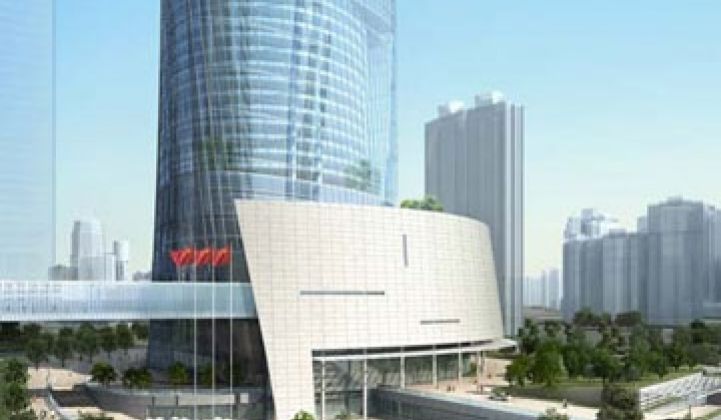SAN FRANCISCO -- The Shanghai Center, due to open in 2014, won’t just be the world’s second tallest building at 632 meters. It will also be a set of neighborhoods stacked on top of each other.
The building will contain eight separate neighborhoods each 14 stories tall, says Dan Winey, managing principal for the Asia Pacific office of the architectural firm Gensler, which designed the building. These neighborhoods will contain retail outlets, office space and residences. But at the outer perimeter of each floor of these neighborhoods will be city parks complete with trees, tables and all of the other stuff (except bums) one would expect in a city park.
“All of the parks will be open to the public,” he said, during a presentation at the Scaling Up conference sponsored by the Asia Society (see The Beijing Watercube: Better Than Solar Panels).
The building will also be covered with a triangular/helix-like skin. “It will be the world’s tallest double-skin building,” Winey added.
Putting the park inside of a building might have dystopian overtones – the only wildlife in Soylent Green, after all, was at the crematorium. But it’s a natural extension of the green building concept and the evolving sense of urbanism. To save energy and resources, people are increasingly going to move toward cities. Forty percent of China’s population already lives in urban centers, according to Stanley Yip, director of planning and development for Arup China, an urban development firm. (China also has two billion square meters of new construction a year, adds Yip.)
“In China, cities are about survival. For the Chinese it is not a lifestyle choice, and it is rapidly becoming the same for America itself,” said John Kriken, a consulting partner with Skidmore Owings and Merrill.
China has taken some steps toward energy efficient urban planning, he noted. Many of the developments by Shui On Land get rave reviews for blending lifestyle comfort into projects. Generic residential structures are aligned east to west to get two hours of natural sunlight a day. If an apartment gets less, it is reclassified as a workspace. Still, miles and miles of east-west apartment blocks creates monotony.
Which brings us back to developments like the Shanghai Center. If people are going to be crowded in cities, they will need open space. And with real estate at a premium, it makes sense to build up. Many panelists at the conference expressed a worry that too much attention is being paid to showcase projects. Still, big projects like these often become test beds for concepts and technologies that are used later on. The proof that energy efficiency and LEED buildings do not have to cost more than conventional buildings was largely derived from showcase projects.
Winey also noted that the center, which will open in 2014 and is part of a three-skyscraper development, would also use far less energy and water than conventional buildings (see Investors High on Water). Rainwater recovery and grey water recycling systems will cut water use by a minimum of 40 percent, he said. The owners may even include black water treatment. This involves taking sewage and purifying it to drinking level standards – Singapore, which imports half of its water from Malaysia, does this already for a small percentage of its water supply. The country officially calls it NEWater.
The 632 meter high tower, which will sport 5.4 million square feet of floor space, will also have wind turbines to run the exterior lights. Cooling and heating, two of the big energy hogs in the world today, will be provided in part through geothermal systems and thermal mass storage, i.e., giant ice machines that will produce ice at night for cooling in the day.
Join industry leaders and influencers at Greentech Media's Green Building Summit in Menlo Park, Calif., June 11.




